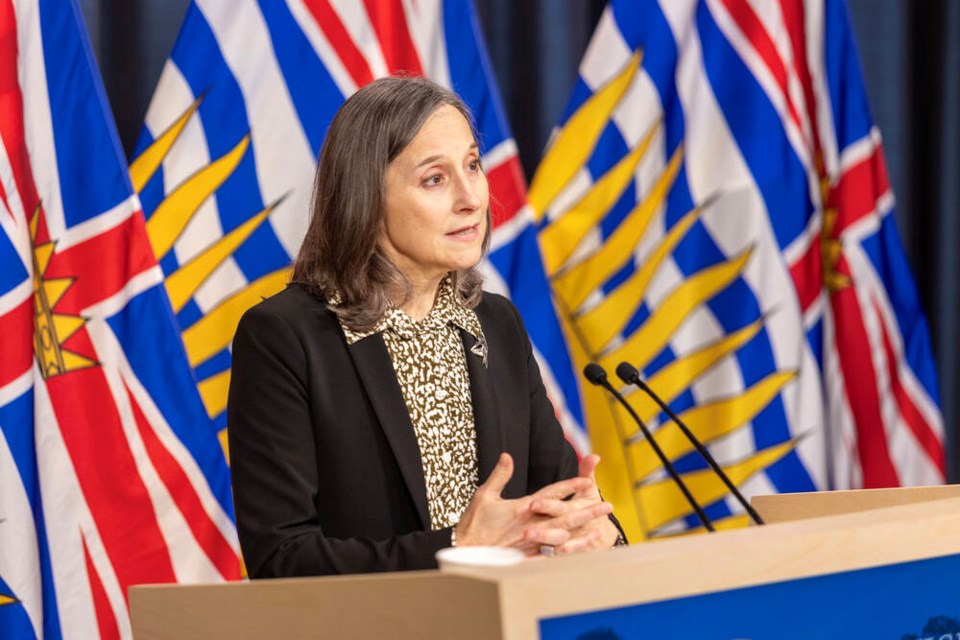A record 2,511 people died of suspected toxic-drug overdoses last year, the highest annual toll ever recorded — and almost one-fifth were from Vancouver Island.
The death toll had dipped in 2019 to fewer than 1,000 deaths, but spiked back up to more than 2,300 two years later.
B.C. chief coroner Lisa Lapointe told a news conference Wednesday that the highly addictive opioid fentanyl remains the main driver of illicit toxic-drug poisonings.
Pender Island resident Leslie Mcbain, co-founder of Moms Stop the Harm, called the record number of deaths — about 7.2 a day in B.C. — heartbreaking.
“And to see that nothing that the government has done is working and to see that we are probably not going to see a change in these horrible numbers for some time is awful,” said Mcbain, whose son Jordan Miller, 25, died from an accidental overdose in February 2014.
In December, a coroner’s death review panel recommended expanded access to safe-supply drugs without a prescription as the quickest way to reduce deaths amid the crisis, but B.C. Mental Health and Addictions Minister Jennifer Whiteside said the government was not considering that model.
Prescribed pharmaceutical alternatives to street drugs have been a life-saving option for people with severe opioid addiction, Whiteside said Wednesday.
A recent study found the program reduced the risk of death by as much as 91% in people with opioid-use disorder, she said. “There are many paths through which people come into addiction, and we must provide many paths out.”
Lapointe said Wednesday that providing safe supply only through prescription will not address the crisis.
“One million people in our province don’t have access to a family doctor, never mind the focused and specialized expertise needed to address a public health emergency of this magnitude,” she said.
An estimated 225,000 people in B.C. get their drugs from the toxic, illicit market, putting them at risk, the chief coroner said. “Unless we are willing to act thoughtfully, carefully and with courage to provide a safer supply for the tens of thousands of people at risk in our province, we will continue to count the dead, more people will suffer and more families will grieve.”
Lapointe said 70 per cent of those who died last year as a result of the toxic-drug crisis were between the ages of 30 and 59, and more than three-quarters were male.
Lapointe said the politicization of the overdose crisis has been “extremely disappointing.”
A year ago, B.C. began allowing adults to possess small amounts of certain drugs — opioids, crack, cocaine, methamphetamine and MDMA — for personal use as part of a three-year pilot project.
Since then, many people have complained about increased use of drugs in public, prompting the province to try to impose limitations on where drugs can be used.
Meanwhile, some doctors have alleged that safe-supply drugs available by prescription, like Dilaudid — hydromorphone — are being sold on the street by users to buy stronger street drugs.
Mcbain said the idea that Dilaudid is “flooding the market” is untrue. Last year, hydromorphone was found in only three per cent of unregulated drug deaths that underwent expedited toxicology testing. Mcbain said she has worked “every single day” since 2015 to see safe supply offered to all those who are addicted and is “devastated” to see the highest number of annual deaths announced Wednesday, along with Lapointe’s upcoming retirement and no bold action on the death review panel’s recommendation.
The coroners service found 80 per cent of illicit toxic drug poisonings in 2013 occurred indoors — 47 per cent in a private residence and 33 per cent in social and supportive housing or shelters and hotels — and 19 per cent occurred outside in vehicles, streets and parks.
BC United Leader Kevin Falcon blamed the rise in the death rate in supportive housing on Premier David Eby, who, as housing minister, “spent a quarter of a billion dollars purchasing motels to warehouse people with severe mental health and addiction issues without the appropriate supports in place.”
Grant McKenzie, spokesperson for Our Place Society, which provides supports including shelter for people who are homeless, struggling with mental-health challenges and addicted, said its supportive housing has consumption sites but “you can’t force people to use them.”
He said opioids on the street now are so deadly that those using them have a high likelihood of being poisoned. “Basically, it’s like playing Russian Roulette with a two-chamber gun and a bullet in one chamber so it’s like a 50-50 chance whether you live or die,” said McKenzie.
“And the addiction is so strong right now that people have become agnostic to death. They don’t necessarily want to die, but it doesn’t really bother them if they do.”
The answer, said McKenzie, is putting more resources into treatment and recovery.
“Logic says if we give people clean supply we will save their life, and eventually they’ll be able to get into recovery and get their lives back on track,” he said, adding the reality is that those who are fiercely addicted want to get high and safe supply isn’t doing that for them.
McKenzie said clean supply of regulated drugs needs to be part of a two-step solution.
“[We have to say] if we’re going to give you a clean supply, you have to have constant medical attention, you have to have psychological attention that deals with your trauma and the abuse in your life that’s led you to this particular path and the end goal has to be sobriety.”
Close to 14,000 people, including 2,510 from the Island, have died since the province declared the toxic-drug crisis a public-health emergency in April 2016.
— With The Canadian Press



